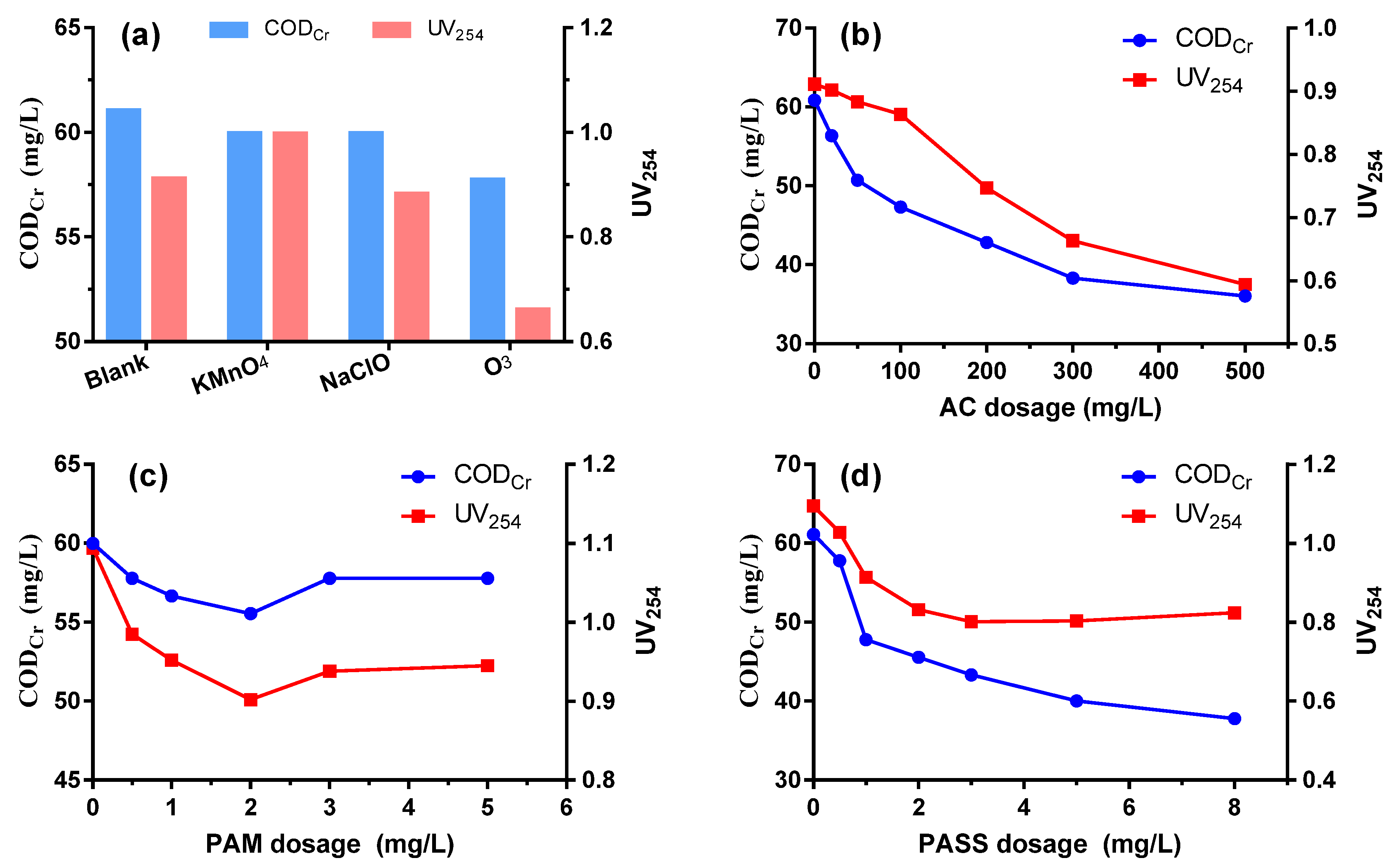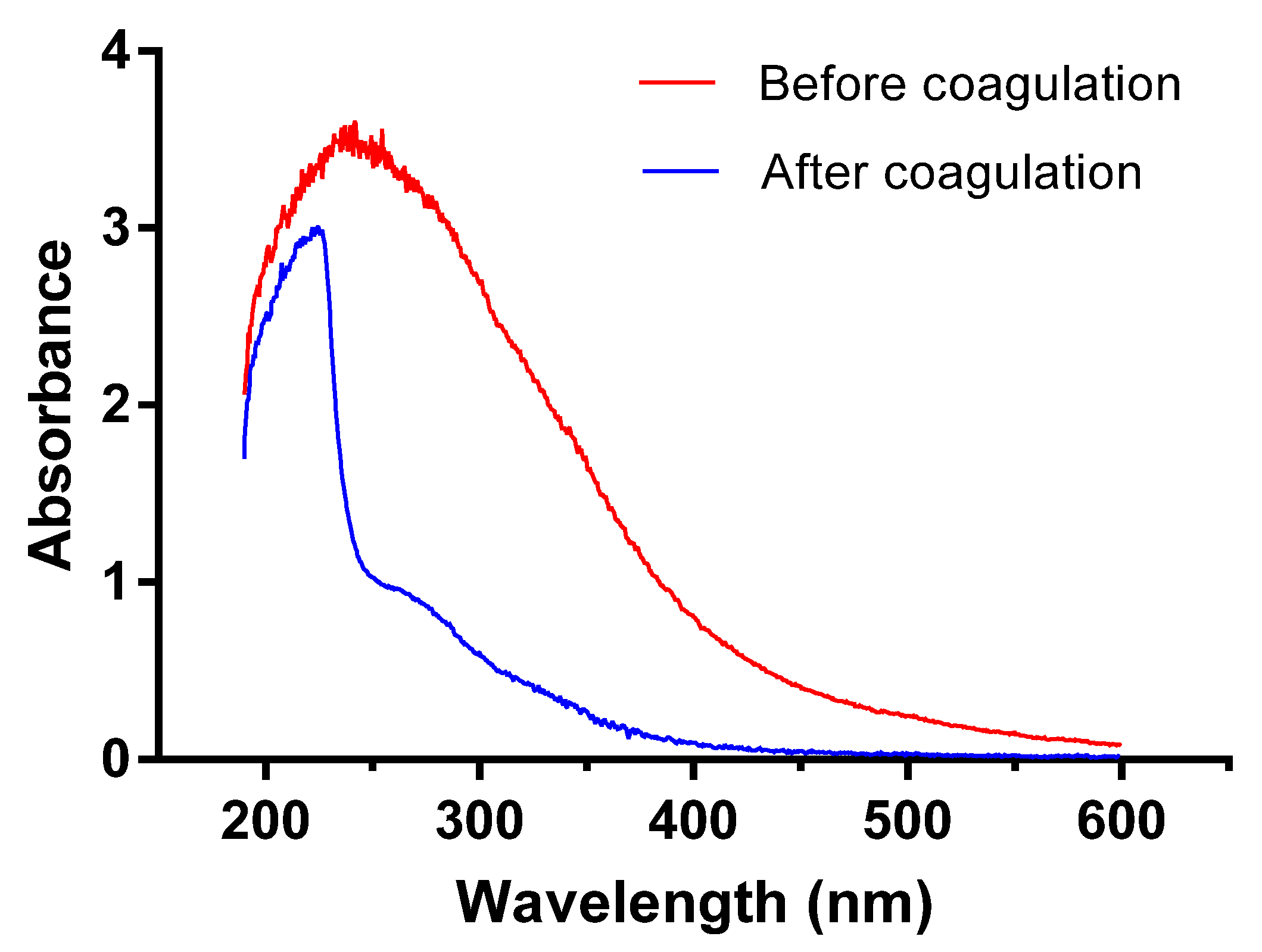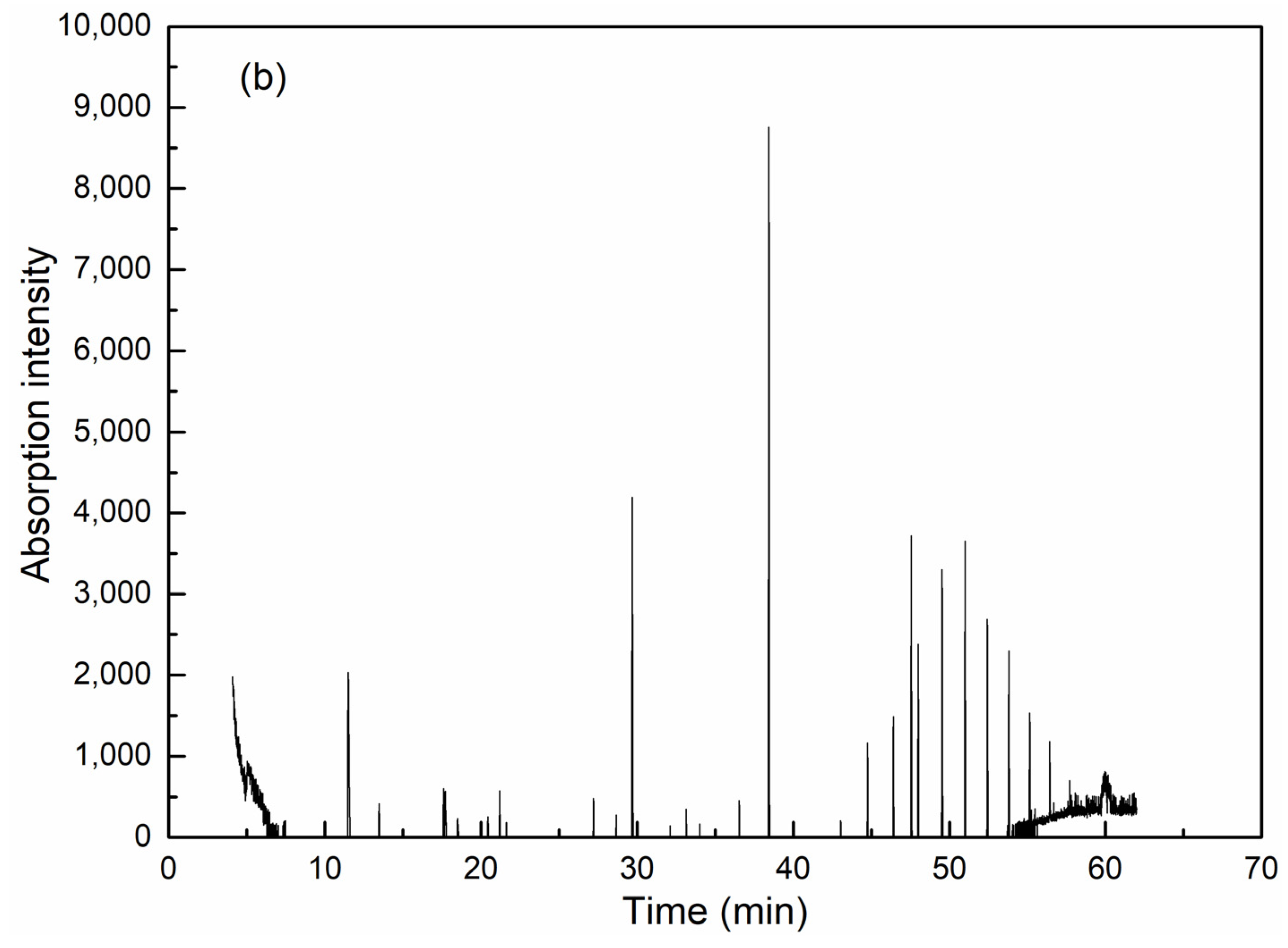Advanced Treatment of Coking Wastewater by Polyaluminum Silicate Sulfate for Organic Compounds Removal
Abstract
:1. Introduction
2. Materials and Methods
2.1. Wastewater
2.2. Preparation of PASS Coagulants
2.3. Jar Tests
2.4. Enhanced Coagulation Experiment
2.5. Analytical Methods
3. Results and Discussion
3.1. Coagulation Performance of PASS
3.2. Optimal Factors Affecting Coagulation Performance
3.2.1. Effect of Flocculation Speed and Time
3.2.2. Effect of pH Value
3.2.3. Impact of Temperature
3.2.4. Impact of Settling Time
3.3. Optimal Results by Taguchi Experiments
3.4. Enhanced Coagulation Results
3.4.1. Pre-Oxidation
3.4.2. Activated Carbon Adsorption
3.4.3. Coagulant Aid Polyacrylamide
3.4.4. Secondary Coagulation
3.5. Coagulation Mechanism Exploration
3.5.1. Ultraviolet Spectrum Scanning
3.5.2. Gas Chromatography-Mass Spectrometry (GC-MS)
4. Conclusions
Author Contributions
Funding
Institutional Review Board Statement
Informed Consent Statement
Data Availability Statement
Conflicts of Interest
References
- Liu, M.; Preis, S.; Kornev, I.; Hu, Y.; Wei, C.H. Pulsed corona discharge for improving treatability of coking wastewater. J. Environ. Sci. 2018, 64, 306–316. [Google Scholar] [CrossRef]
- Zhou, N.; Zhao, Z.; Wang, H.; Chen, X.; Wang, M.; He, S.; Liu, W.; Zheng, M. The effects of graphene oxide on nitrification and N2O emission: Dose and exposure time dependent. Environ. Pollut. 2019, 252, 960–966. [Google Scholar] [CrossRef]
- Farris, F.F. Coke oven emissions. In Encyclopedia of Toxicology, 3rd ed.; Academic Press: Cambridge, MA, USA, 2014; Volume 1. [Google Scholar] [CrossRef]
- Guo, D.; Shi, Q.; He, B.; Yuan, X. Different solvents for the regeneration of the exhausted activated carbon used in the treatment of coking wastewater. J. Hazard. Mater. 2011, 186, 1788–1793. [Google Scholar] [CrossRef]
- Kumar, A.; Sengupta, B.; Kannaujiya, M.; Priyadarshinee, R.; Singha, S.; Dasguptamandal, D.; Mandal, T. Treatment of coke oven wastewater using ozone with hydrogen peroxide and activated carbon. Desalination Water Treat. 2017, 69, 352–365. [Google Scholar] [CrossRef]
- Tian, Z.; Zhou, N.; You, W.; He, D.; Chang, F.; Zheng, M. Mitigating NO and N2O emissions from a pilot-scale oxidation ditch using bioaugmentation of immobilized aerobic denitrifying bacteria. Bioresour. Technol. 2021, 340, 125704. [Google Scholar] [CrossRef]
- Zheng, M.; Zhou, N.; Liu, S.; Dang, C.; Liu, Y.; He, S.; Zhao, Y.; Liu, W.; Wang, X. N2O and NO emission from a biological aerated filter treating coking wastewater: Main source and microbial community. J. Clean. Prod. 2019, 213, 365–374. [Google Scholar] [CrossRef]
- Rodríguez-Hernández, L.; Esteban-García, A.L.; Tejero, I. Comparison between a fixed bed hybrid membrane bioreactor and a conventional membrane bioreactor for municipal wastewater treatment: A pilot-scale study. Bioresour. Technol. 2014, 152, 212–219. [Google Scholar] [CrossRef]
- Verma, V.; Joshi, N.; Kushwaha, J.; Singh, S.B.; Ghosh, P.; Chaudhari, P.K. Catalytic thermolysis at atmospheric pressure followed by adsorption in treatment of coking wastewater. Int. J. Chem. React. Eng. 2022, 20, 627–639. [Google Scholar] [CrossRef]
- Yang, X.; Duan, J.; Zhang, X.; Zhang, H.; Liu, X.; Feng, Y.; Zheng, M. Heterojunction architecture of Nb2O5/g-C3N4 for enhancing photocatalytic activity to degrade organic pollutants and deactivate bacteria in water. Chin. Chem. Lett. 2022, 33, 3792–3796. [Google Scholar] [CrossRef]
- Pal, P.; Kumar, R. Treatment of coke wastewater: A critical review for developing sustainable management strategies. Sep. Purif. Rev. 2014, 43, 89–123. [Google Scholar] [CrossRef]
- Zhang, F.Z.; Wu, K.Y.; Zhou, H.T.; Hu, Y.; Sergei, P.; Wu, H.Z.; Wei, C.H. Ozonation of aqueous phenol catalyzed by biochar produced from sludge obtained in the treatment of coking wastewater. J. Environ. Manag. 2018, 224, 376–386. [Google Scholar] [CrossRef]
- Biache, C.; Mansuy-Huault, L.; Faure, P. Impact of oxidation and biodegradation on the most commonly used polycyclic aromatic hydrocarbon (PAH) diagnostic ratios: Implications for the source identifications. J. Hazard. Mater. 2014, 267, 31–39. [Google Scholar] [CrossRef]
- Sharma, N.; Philip, L. Combined biological and photocatalytic treatment of real coke oven wastewater. Chem. Eng. J. 2016, 295, 20–28. [Google Scholar] [CrossRef]
- Ryu, B.-G.; Kim, J.; Han, J.-I.; Kim, K.; Kim, D.; Seo, B.-K.; Kang, C.-M.; Yang, J.-W. Evaluation of an electro-flotation-oxidation process for harvesting bio-flocculated algal biomass and simultaneous treatment of residual pollutants in coke wastewater following an algal-bacterial process. Algal Res. 2018, 31, 497–505. [Google Scholar] [CrossRef]
- Minhalma, M.; de Pinho, M.N. Integration of nanofiltration/steam stripping for the treatment of coke plant ammoniacal wastewaters. J. Membr. Sci. 2004, 242, 87–95. [Google Scholar] [CrossRef]
- Li, J.; Yuan, X.; Zhao, H.; Li, F.; Lei, Z.; Zhang, Z. Highly efficient one-step advanced treatment of biologically pretreated coking wastewater by an integration of coagulation and adsorption process. Bioresour. Technol. 2018, 247, 1206–1209. [Google Scholar] [CrossRef]
- Lee, C.S.; Robinson, J.; Chong, M.F. A review on application of flocculants in wastewater treatment. Process Saf. Environ. Prot. 2014, 92, 489–508. [Google Scholar] [CrossRef]
- Joo, D.; Shin, W.; Choi, J.; Choi, S.; Kim, M.; Han, M.; Ha, T.; Kim, Y. Decolorization of reactive dyes using inorganic coagulants and synthetic polymer. Dye. Pigment. 2007, 73, 59–64. [Google Scholar] [CrossRef]
- Gao, B.Y.; Wang, Y.; Yue, Q.Y.; Wei, J.C.; Li, Q. Color removal from simulated dye water and actual textile wastewater using a composite coagulant prepared by ployferric chloride and polydimeth yldiallyl ammonium chloride. Separ. Purif. Technol. 2007, 54, 157–163. [Google Scholar] [CrossRef]
- Coca, J.; Bueno, J.; Sastre, H. Zeta Potential and the Effect of Coagulants on Coal Slurries. J. Chem. Eng. Jpn. 1983, 16, 335–338. [Google Scholar] [CrossRef] [Green Version]
- Yang, Z.H.; Huang, J.; Zeng, G.M.; Ruan, M.; Zhou, C.S.; Li, L.; Rong, Z.G. Optimization of flocculation conditions for kaolin suspension using the composite flocculant of MBFGA1 and PAC by response surface methodology. Bioresour. Technol. 2009, 100, 4233–4239. [Google Scholar] [CrossRef] [PubMed]
- Osborne, D. Flocculant behaviour with coal—Shale slurries. Int. J. Miner. Process. 1974, 1, 243–260. [Google Scholar] [CrossRef]
- Rebah, F.B.; Mnif, W.; Siddeeg, S.M. Microbial flocculants as an alternative to synthetic polymers for wastewater treatment: A Review. Symmetry 2018, 10, 556. [Google Scholar] [CrossRef] [Green Version]
- Li, J.; Li, J.; Liu, X.; Du, Z.; Cheng, F. Effect of silicon content on preparation and coagulation performance of poly-silicic-metal coagulants derived from coal gangue for coking wastewater treatment. Sep. Purif. Technol. 2018, 202, 149–156. [Google Scholar] [CrossRef]
- Saravanan, A.; Thamarai, P.; Kumar, P.S.; Rangasamy, G. Recent advances in polymer composite, extraction, and their application for wastewater treatment: A review. Chemosphere 2022, 308, 136368. [Google Scholar] [CrossRef] [PubMed]
- Arnold-Smith, A.K.; Christie, R.M.; Jolicoeur, C. Polyaluminium Silicate Sulphate—A New Coagulant for Potable and Wastewater Treatment. In Chemical Water and Wastewater Treatment II, Proceedings of the 5th Gothenburg Symposium, Nice, France, 28–90 September 1992; Springer: Berlin/Heidelberg, Germany, 1992. [Google Scholar]
- Abujazar, M.S.S.; Karaağaç, S.U.; Abu Amr, S.S.; Alazaiza, M.Y.D.; Bashir, M.J. Recent advancement in the application of hybrid coagulants in coagulation-flocculation of wastewater: A review. J. Clean. Prod. 2022, 345, 131133. [Google Scholar] [CrossRef]
- Zhao, H.; Peng, J.; Lin, S.; Zhang, Y. Covalently Bound Organic Silicate Aluminum Hybrid Coagulants: Preparation, Characterization, and Coagulation Behavior. Environ. Sci. Technol. 2009, 43, 2041–2046. [Google Scholar] [CrossRef]
- Zheng, M.; Zhou, N.; He, S.; Chang, F.; Zhong, J.; Xu, S.; Wang, Z.; Liu, T. Nitrous oxide (N2O) emissions from a pilot-scale oxidation ditch under different COD/N ratios, aeration rates and two shock-load conditions. J. Environ. Manag. 2021, 280, 111657. [Google Scholar] [CrossRef]
- Zheng, M.; Mu, G.; Zhang, A.; Wang, J.; Chang, F.; Niu, J.; Wang, X.; Gao, T.; Zhao, Z. Predominance of comammox bacteria among ammonia oxidizers under low dissolved oxygen condition. Chemosphere 2022, 308, 136436. [Google Scholar] [CrossRef]
- Cheng, W.P.; Chi, F.H.; Li, C.C.; Yu, R.F. A study on the removal of organic substances from low-turbidity and low-alkalinity water with metal-polysilicate coagulants. Colloids Surf. A Physicochem. Eng. Asp. 2008, 312, 238–244. [Google Scholar] [CrossRef]
- Lai, P.; Zhao, H.; Wang, C.; Ni, J.-R. Advanced treatment of coking wastewater by coagulation and zero-valent iron processes. J. Hazard. Mater. 2007, 147, 232–239. [Google Scholar] [CrossRef] [PubMed]
- Du, Z.; Gong, Z.; Qi, W.; Li, E.; Shen, J.; Li, J.; Zhao, H. Coagulation performance and floc characteristics of poly-ferric-titanium-silicate-chloride in coking wastewater treatment. Colloids Surf. A Physicochem. Eng. Asp. 2022, 642, 128413. [Google Scholar] [CrossRef]
- Li, S.; Kang, Y. Impacts of key preparation factors on polymerization and flocculation performance of polyferric silicate sulfate (PFSiS). Colloids Surf. A Physicochem. Eng. Asp. 2022, 635, 128109. [Google Scholar] [CrossRef]
- Singhania, R.R.; Sukumaran, R.K.; Pandey, A. Improved cellulase production by Trichoderma reesei RUT C30 under SSF through process optimization. Appl. Biochem. Biotechnol. 2007, 142, 60–70. [Google Scholar] [CrossRef]
- Uyak, V.; Yavuz, S.; Toroz, I.; Ozaydin, S.; Genceli, E.A. Disinfection by-products precursors removal by enhanced coagulation and PAC adsorption. Desalination 2007, 216, 334–344. [Google Scholar]
- Gui, Z.; Qian, J.; Li, X.; Zheng, B.Q.; An, Q.F. Study on Chain Deformation of Polyacrylamides in Solutions and Its Flocculation Performance During the Flocculation Process. J. Appl. Polym. Sci. 2010, 117, 2915–2922. [Google Scholar] [CrossRef]







| Dosage (mmol/L) | Mixing Speed (r/min) | Mixing Time (min) | pH Value | Temperature (°C) | CODCr (mg/L) | UV254 | |
|---|---|---|---|---|---|---|---|
| 1 | 3 | 50 | 5 | 6 | 15 | 97.68 | 1.518 |
| 2 | 3 | 70 | 10 | 7 | 20 | 82.14 | 1.416 |
| 3 | 3 | 90 | 15 | 8 | 25 | 101.01 | 1.810 |
| 4 | 3 | 110 | 20 | 9 | 30 | 125.43 | 2.289 |
| 5 | 5 | 50 | 10 | 8 | 30 | 69.93 | 1.252 |
| 6 | 5 | 70 | 5 | 9 | 25 | 74.37 | 1.426 |
| 7 | 5 | 90 | 20 | 6 | 20 | 75.48 | 1.348 |
| 8 | 5 | 110 | 15 | 7 | 15 | 64.38 | 1.019 |
| 9 | 7 | 50 | 15 | 9 | 20 | 58.83 | 1.030 |
| 10 | 7 | 70 | 20 | 8 | 15 | 58.83 | 0.959 |
| 11 | 7 | 90 | 5 | 7 | 30 | 54.39 | 0.915 |
| 12 | 7 | 110 | 10 | 6 | 25 | 67.71 | 1.433 |
| 13 | 9 | 50 | 20 | 7 | 25 | 71.04 | 1.078 |
| 14 | 9 | 70 | 15 | 6 | 30 | 78.81 | 1.623 |
| 15 | 9 | 90 | 10 | 9 | 15 | 45.51 | 0.880 |
| 16 | 9 | 110 | 5 | 8 | 20 | 43.29 | 0.884 |
| Retention Time (min) | Organic Compound Name | Before Coagulation | After Coagulation | Removal Efficiency (%) | ||
|---|---|---|---|---|---|---|
| Peak Area | Proportion (%) | Peak Area | Proportion (%) | |||
| 11.479 | 2-cyclohexen-1-one | 1,620,727 | 3.09 | 95,208 | 12.30 | 94.13 |
| 17.555 | 1-ethyl-4-piperidone | 344,708 | 0.66 | |||
| 17.646 | 3-ethyl-2,4-dimethylpyrrole | 416,969 | 0.79 | |||
| 21.181 | benzothiazole | 264,600 | 0.50 | |||
| 29.675 | 1,8-naphthalimide | 1,338,682 | 2.55 | 98,566 | 12.73 | 92.64 |
| 33.200 | cyclopentyl-hydantoin | 562,414 | 1.07 | |||
| 38.441 | 1,2-benzenedicarboxylic acid, butyl cyclohexyl ester | 2,135,102 | 4.07 | 190,546 | 24.61 | 91.08 |
| 38.575 | hexadecanoic acid | 845,638 | 1.61 | |||
| 40.752 | methylcholanthrene | 458,356 | 0.87 | |||
| 43.030 | tetratriacontane | 286,472 | 0.55 | |||
| 44.753 | docosane | 670,453 | 1.28 | |||
| 46.405 | docosane | 1,138,506 | 2.17 | |||
| 47.561 | 2,4-bis(1-phenylethyl) phenol | 3,352,312 | 6.39 | 83,596 | 10.80 | 97.51 |
| 47.999 | heneicosane | 1,966,420 | 3.75 | 47,928 | 6.19 | 97.56 |
| 49.529 | heneicosane | 3,264,155 | 6.22 | 69,020 | 8.91 | 97.89 |
| 51.010 | heneicosane | 4,398,514 | 8.38 | 79,435 | 10.26 | 98.19 |
| 52.433 | heneicosane | 4,159,765 | 7.92 | 60,745 | 7.84 | 98.54 |
| 52.578 | dqualene | 424,800 | 0.81 | |||
| 53.813 | pentatriacontane | 4,063,962 | 7.74 | 49,293 | 6.37 | 98.79 |
| 55.140 | octacosane | 2,695,909 | 5.14 | |||
| 56.429 | heptacosane | 2,080,623 | 3.96 | |||
| 57.707 | henicosane | 1,053,509 | 2.01 | |||
| 59.151 | tetratriacontane | 636,520 | 1.21 | |||
Disclaimer/Publisher’s Note: The statements, opinions and data contained in all publications are solely those of the individual author(s) and contributor(s) and not of MDPI and/or the editor(s). MDPI and/or the editor(s) disclaim responsibility for any injury to people or property resulting from any ideas, methods, instructions or products referred to in the content. |
© 2023 by the authors. Licensee MDPI, Basel, Switzerland. This article is an open access article distributed under the terms and conditions of the Creative Commons Attribution (CC BY) license (https://creativecommons.org/licenses/by/4.0/).
Share and Cite
Wang, J.; Chang, F.; Zheng, M. Advanced Treatment of Coking Wastewater by Polyaluminum Silicate Sulfate for Organic Compounds Removal. Int. J. Environ. Res. Public Health 2023, 20, 6342. https://doi.org/10.3390/ijerph20146342
Wang J, Chang F, Zheng M. Advanced Treatment of Coking Wastewater by Polyaluminum Silicate Sulfate for Organic Compounds Removal. International Journal of Environmental Research and Public Health. 2023; 20(14):6342. https://doi.org/10.3390/ijerph20146342
Chicago/Turabian StyleWang, Jiangnan, Fang Chang, and Maosheng Zheng. 2023. "Advanced Treatment of Coking Wastewater by Polyaluminum Silicate Sulfate for Organic Compounds Removal" International Journal of Environmental Research and Public Health 20, no. 14: 6342. https://doi.org/10.3390/ijerph20146342





